As if I needed another war game project! I’ve started working on an updated version of Mike Frank’s Napoleonic Division rules. Funny thing is that I thought we had posted his original rules, but in checking I cannot find them (here or on the HistoriFigs site). Perhaps they were only posted on Bob’s Yahoo Group (sorry Bob, I am drawing a blank on the group name). So, I guess most of this will be all new for most of you.
I’m not sure when Mike first came up with these rules. I do know it was at least 10 years ago, perhaps more. In a nutshell: We use Scruby N-gauge Napoleonic figures mounted on stands. Each stand represents a full Division. Each player will command at least a Corps – usually more than 1. A single corps is made up of 1 or more Divisions and is commanded by a Corps Commander. The overall command for each army is the Commander in Chief (CiC). Each Division stand measures 4 1/2″ in width x 2″ in depth. Corps Commanders (and staff) are based on 2″ squares while the CiC is based with 2 1/2″ frontage x 2″ in depth. The time and distance scales are not identified; at this level, we can fudge a bit here and there and the game still works. More about the game mechanics in the next posting (where we will present the first of the re-writes).
Before going too much further; I should touch upon the reasoning behind the re-write. Firstly, the rules were never really complete as written. Mike knew how the game worked, and we rarely ever played the game unless Mike was running it so this wasn’t a big deal. Now that I want to use this game with a group of Middle and High School students we need a more completely written set of rules. That said, these rules will never be fully fleshed out. Meaning that they will not be as complete as a commercial set of rules. I do, however, intend to make them complete enough that you, or any war gamer with some experience can pick them up and play a game. My last reason for the re-write is that I wanted to streamline a few of the game mechanics (in some cases I think I’m succeeding. In others, well maybe not – we shall see).
We recently completed a play-test of the current draft of the rules. We made a ton of mistakes! That is what I get when I don’t write out an expanded Sequence of Play. I don’t think I need a flowchart, but an expanded or annotated Sequence of Play would keep me form forgetting things. For our game we decided to target a smaller table: 6′ x 4′ – the reason being that we will often times play at the local game store and the tables are smaller. That, and while I have a larger table at home, I’ve been drifting towards smaller table size for our games. Well, alight then, on to a short recap of the game (along with a couple of really bad photos – I forgot to reset the camera settings – so we got lower quality pictures than I would have liked).
The training game is a simple scenario. Pretty much a meeting engagement. Two armies meet on a more or less symmetrical battle field. Each has control of a town on t’s right flank. There are woods just outside of the town. There are two more towns, on the center line. One each on the right and left flanks. Leaving the center open. The armies are similar to each other; consisting of three Corps each. Each Corps is composed of three Infantry Divisions and one Cavalry Division. The French are commanded by Napoleon and the Russians by Bagration. The French Corps commanders are: Ney on the Right, Victor in the Center and Mortier on the Left. The Russian Corps Commanders are Gortchakov on the Right, Langeron in the Center and Vlastov on the Left. We decided on a 10 turn limit for this game.
The battle was fairly even through the first 5 turns – the Russians with a slight advantage, having captured the two open towns.
As the game progressed, the Russians dominated their Left. Once the town was captured it remained in Russian control the remainder of the game. The Russians, took a beating but dis not loose a single Division. While a full 50% of the French force was driven form the field in this sector.
In the center the story was a little different. Here the French had the upper hand. By the end of the game they were a bit scattered, but still holding strong having eliminated 1/2 of the Russian Center.
As we move to the Russian right; we had a strong Russian opening followed by a bitter fight for the open town. The French were able to dislodge the Russians from the town. However, the Russians fought a fierce battle to recapture the population center and in the end dominated the sector, leaving a single, French Cavalry Division on the field.
Had the game continued beyond the 10th turn; the French Center would have been able to re-group and turn on the Russian Right. This would have made for an interesting fight. Not sure how it would have gone, but I think the French would have had an advantage on the Russian Right.
At the end of our ten turns we scored the game; arriving at a Russian Victory (189 points for the Russians to the French 125 points – more on victory points next time).
I think we will have time for one more play through the rules before I need to switch gears and jump into the American Revolution (time to revisit the Bloodybacks rules) for the Middle/High School group.
More with, hopefully better pictures next time.


